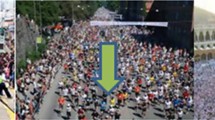Abstract
Abnormal crowd behavior detection is an important research issue in computer vision. The traditional methods first extract the local spatio-temporal cuboid from video. Then the cuboid is described by optical flow or gradient features, etc. Unfortunately, because of the complex environmental conditions, such as severe occlusion, over-crowding, etc., the existing algorithms cannot be efficiently applied. In this paper, we derive the high-frequency and spatio-temporal (HFST) features to detect the abnormal crowd behaviors in videos. They are obtained by applying the wavelet transform to the plane in the cuboid which is parallel to the time direction. The high-frequency information characterize the dynamic properties of the cuboid. The HFST features are applied to the both global and local abnormal crowd behavior detection. For the global abnormal crowd behavior detection, Latent Dirichlet allocation is used to model the normal scenes. For the local abnormal crowd behavior detection, Multiple Hidden Markov Models, with an competitive mechanism, is employed to model the normal scenes. The comprehensive experiment results show that the speed of detection has been greatly improved using our approach. Moreover, a good accuracy has been achieved considering the false positive and false negative detection rates.
Similar content being viewed by others
References
Reisman, P., Mano, S.A.O., Shashua, A.: Crowd detection in video sequences. In: Proceedings of the IEEE Intelligent Vehicles Symposium, 2004, pp. 66–71, June 2004
Mehran, R., Oyama, A., Shah, M.: Abnormal crowd behavior detection using social force model. In: Proceedings of the IEEE Computer Society Conference on Computer Vision and Pattern Recognition (2009)
Kratz, L., Nishino, K.: Anomaly detection in extremely crowded scenes using spatio-temporal motion pattern models. In: Proceedings of the IEEE Computer Society Conference on Computer Vision and Pattern Recognition (2009)
Helbing D., Molnár P., Farkas I.J., Bolay K.: Self-organizing pedestrian movement. Environ. Plan. B Plan. Des. 28, 361–383 (2001)
Zhan B., Monekosso D.N., Remagnino P., Velastin S.A., Xu L.-Q.: Crowd analysis: a survey. Mach. Vis. Appl. 19(5–6), 345–357 (2008)
Haering N., Venetianer P., Lipton A.: The evolution of video surveillance: an overview. Mach. Vis. Appl. 19(5), 279–290 (2008)
Tu, P., Sebastian, T., Doretto, G., Krahnstoever, N., Rittscher, J., Yu, T.: Unified crowd segmentation. ECCV, pp. 691–704 (2008)
Marques, J.S., Jorge, P.M., Abrantes, A.J., Lemos, J.M.: Tracking Groups of Pedestrians in Video Sequences. In: Proceedings of the IEEE Conference on Computer Vision and Pattern Recognition Workshop 2003, vol. 9, pp. 101 (2003)
Chan, M.T., Hoogs, A., Schmiederer, J., Petersen, M.: Detecting rare events in video using semantic primitives with HMM. In: Proceedings of International Conference on Pattern Recognition, pp. 150–154 (2004)
Gryn, J., Wildes, R., Tsotsos, J.: Detecting motion patterns via direction maps with application to surveillance. In: Proceedings of the IEEE Workshop on Motion and Video Computing, pp. 202–209 (2005)
Johnson, N., Hogg, D.: Learning the distribution of object trajectories for event recognition. In: Proceedings of British Machine Vision Conference, pp. 583–592 (1995)
Chan, M.T., Hoogs, A., Schmiederer, J., Petersen, M.: Detecting rare events in video using semantic primitives with HMM. In: Proceedings of International Conference on Pattern Recognition, pp. 150–154 (2004)
Dee, H., Hogg, D.: Detecting inexplicable behaviour. In: Proceedings of British Macine Vision Conference, pp. 477–486 (2004)
Chan, A.B., Vasconcelos, N.: Mixtures of dynamic textures. In: ICCV’05: Proceedings of the Tenth IEEE International Conference on Computer Vision, vol. 1, pp. 641–647. Washington, DC, USA, IEEE Computer Society (2005)
Andrade, E.L., Blunsden, S., Fisher, R.B.: Modeling crowd scenes for event detection. In: Proceedings of the 18th International Conference on Pattern Recognition (ICPR’06), vol. 01, pp. 175–178. IEEE Computer Society Washington, DC (2006)
Ali, S., Shah, M.: A Lagrangian particle dynamics approach for crowd flow segmentation and stability analysis. In: Proceedings of the IEEE Conference on Computer Vision and Pattern Recognition, 2007, CVPR’07, pp. 1–6, June 2007
Ali, S., Shah, M.: Floor fields for tracking in high density crowd scenes. In: ECCV’08: Proceedings of the 10th European Conference on Computer Vision, pp. 1–14. Springer, Berlin (2008)
Black, M.: Explaining optical flow events with parameterized spatio-temporal models. In: Proceedings of the IEEE International Conference on Computer Vision and Pattern Recognition, pp. 326–332 (1999)
Helbing D., Molnar P.: Social force model for pedestrian dynamics. Phys. Rev. E 51, 4282 (1995)
Blei D., Ng A., Jordan M.: Latent Dirichlet allocation. J. Mach. Learn. Res. 3, 993–1022 (2003)
Burrus C.S., Gopinath R.A., Guo H.: Introduction to wavelets and wavelet transforms, pp. 7458. Prentice-Hall, Englewood Cliffs (1998)
Cohen A., Daubechies I., Feauveau J.-C.: Biorthogonal bases of compactly supported wavelets. Commun. Pure Appl. Math. 45(5), 485–560 (1992)
Jolliffe I.T.: Principal Component Analysis. Springer, New York (1986)
Fei-Fei, L., Fergus, R., Torralba, A.: Recognizing and learning object categories. Tutorial at ICCV (2005)
Dempster A.P., Laird N.M., Rubin D.R.: Maximum likelihood from incomplete date via the EM algorithm. J. R. Stat. Soc. Ser. B 39(1), 1–38 (1977)
Bishop, C.M.: Pattern Recognition and Machine Learning. pp. 76–78. Springer, New York (2006)
Andrade, E., Fisher, R.: Hidden Markov models for optical flow analysis in crowds. In: Proceedings of the 18th International Conference on Pattern Recognition (ICPR06), vol. 01, pp. 460C463. IEEE Computer Society Washington (2006)
Rabiner, L.R.: A tutorial on hidden Markov models and selected applications in speech recognition. In: Proceedings of IEEE, vol. 77, no. 2, pp. 257–285 (1989)
Gui L., Thiran J.P., Paragios N.: Cooperative object segmentation and behavior inference in image sequences. Int. J. Comput. Vis. 84(2), 146–162 (2009)
Unusual crowd activity dataset of University of Minnesota. Available from http://mha.cs.umn.edu/movies/crowdactivity-all.avi
Author information
Authors and Affiliations
Corresponding author
Rights and permissions
About this article
Cite this article
Wang, B., Ye, M., Li, X. et al. Abnormal crowd behavior detection using high-frequency and spatio-temporal features. Machine Vision and Applications 23, 501–511 (2012). https://doi.org/10.1007/s00138-011-0341-0
Received:
Revised:
Accepted:
Published:
Issue Date:
DOI: https://doi.org/10.1007/s00138-011-0341-0




